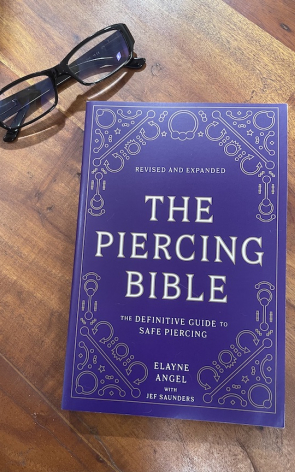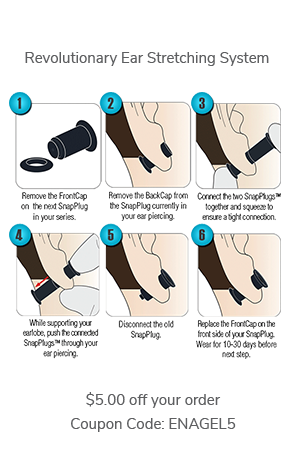I received this message from a Health Education Specialist at a university:
Ms Angel,
I am a Health Educator at the University of Louisville and I'm trying to find some medically accurate information on genital piercings, including risks, long-term side-affects, and questions that potential pierce-ees should research before determining whether to obtain one.
Can you help guide me to this info? I see that you have some info on your website for men, but the link to info for women takes me to a promo for some events that you have coming up.
I really appreciate your help!
Kathleen Conte, M.A.
Health Education Specialist
University of Louisville
Campus Health Services
Office of Health Promotion and Education
My reply:
My book The Piercing Bible--The Definitive Guide to Safe Body Piercing contains a ton of related information, and you're welcome to use excerpts with attribution. A free preview is available on Google books, which shows about 30% of the content: http://books.google.com/books?id=83sjmTPnz48C&
Here's some information on the importance of selecting a qualified piercer for genital piercing:
Genital Piercing: Selecting the Right Piercer
Genital piercing is special because there is the potential to affect your sexual pleasure.
A poorly placed piercing can result in a missed opportunity for enhancement or even
a temporary or permanent loss of sensation. Because of variations in genital anatomy
and personal preferences for sexual stimulation, each piercee must be evaluated (and
even counseled) on an individual basis before deciding on a genital piercing.
Locate an experienced professional who has had specific training in placing and
performing genital piercings, and who can communicate with you openly. The right
piercer will have a professional manner that helps you feel comfortable and safe.
Your piercer must be able to undertake her role with sensitivity, and you must be
prepared to honestly describe what you expect from your piercing. Many piercers sim-
ply do not have enough knowledge to guide you and cannot determine, for instance,
whether a certain placement is more simulating or ornamental. A good piercer will
have an in-depth conversation with you to be sure that you have all the education you
need to make an informed decision about your piercing. Don’t settle for a piercer who
does not impress you with her vast knowledge and outstanding qualifications.
In order to place piercings properly, your piercer must scrutinize your genitals
and may need to do some stretching, tugging, and pinching of your tissue to take a
close look for veins or other vital structures. For accurate placement, the area must
be marked, and then the skin may need to be moved. For men, the tissue may have
to be pulled taut (as it is when you are erect), and if you have a foreskin, it may need
to be retracted. If you are a novice piercee you might misconstrue these activities as
being sexual in nature, but these procedures are invaluable for accurate placement.
Nonetheless, always listen to your intuition. It is appropriate to call off your piercing if
you believe your piercer is behaving unprofessionally.
Below is some of the section from The Piercing Bible about the risks of piercings. These are risks that relate to all essentially all piercings, including genital piercings.
Is Piercing Risky?
A great deal of hype and hysteria about body piercing is perpetuated by the media and
by conservative religious, medical, and educational communities. They describe pierc-
ing as a highly dangerous behavior related to everything from juvenile delinquency to
cancer and death.
Usually, the only piercings that receive attention in the press are the problematic
ones, which skew the statistics and magnify the perils. Thousands upon thousands of
piercings heal without incident every year, but nobody hears about them because they
are not newsworthy.
Educate yourself before getting pierced so you will be ready to deal with any prob-
lems that do occur. An introduction to the most common piercing risks is presented
here. In-depth information on identifying and troubleshooting these and other compli-
cations is presented in chapter 16.
Infection
Infection is one of the most frightening and potentially serious dangers associated
with body piercing. Two distinct phases are of concern: If you get pierced in unsanitary
conditions, or with unsterile implements or jewelry, an infection can be transmitted
during the piercing. Or, if you fail to care for the wound properly throughout its healing
period, you can get an infection after the piercing is done. Studies show that the risk of
infection increases when either the piercer’s technique or the aftercare is poor.3
The incidence of infection is difficult to calculate because there is no reliable infor-
mation about how many piercings are actually being performed. Some smaller studies
done on college campuses usually reveal more about the quality of nearby piercers than they do about the rate of infection for body piercing in general.
Migration and Rejection
Two rather distinctive piercing complications are migration (the piercing moves from
its initial placement, then settles and heals in a new location) and rejection (the jewelry
is expelled completely from the body). The piercing is likely to migrate when unsuitable
or insufficient tissue is pierced, or if your jewelry is too small in diameter, thin in gauge,
or of poor quality. Inexperienced and untrained piercers often make these errors.
Migration and rejection can also result from using a harsh aftercare product, follow-
ing poor health habits, or experiencing excessive physical trauma or emotional stress
during the healing period. And, unfortunately, sometimes even when everything is
done properly, a piercing will migrate or reject for no known reason. This is simply
a risk of placing a foreign object through your skin: it may not stay in the desired
position.
Allergies and Skin Problems
All sorts of bumps, lumps, and skin irritations can crop up around a piercing, com-
ing and going as healing progresses and occasionally remaining permanently. Some
of these are caused by mechanical stress against the piercing; others are caused by a
cleaning product or jewelry material. Skin disorders can be difficult to diagnose, even
for dermatologists, so experimentation is needed at times to identify and correct a
problem. Conditions can also have a combination of causes, which further complicates
diagnosis and treatment.
A nickel allergy can be triggered by jewelry made of inferior metal. This type of
allergy can be serious and irreversible, which is one reason it is critical to wear only
high-quality, inert jewelry (see “Jewelry Materials for Initial Piercings,” page 74).




